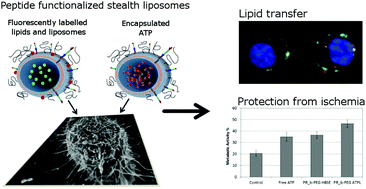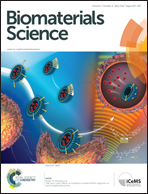Maintenance of ischemic β cell viability through delivery of lipids and ATP by targeted liposomes†
Abstract
Islet transplantation is a promising treatment for type 1 diabetes, but despite the successes, existing challenges prevent widespread application. Ischemia, occurring during pancreas preservation and isolation, as well as after islet transplantation, decreases islet viability and function. We hypothesized that the liposomal delivery of adenosine triphosphate (ATP) could prevent the loss of cell viability during an ischemic insult. In this work we use a model β cell line, INS-1 to probe the liposome–cell interactions and examined the ability of liposomes functionalized with the fibronectin-mimetic peptide PR_b to facilitate the delivery of ATP to ischemic β cells. We demonstrate that PR_b increases the binding and internalization of liposomes to the β cells. Unexpectedly, when comparing the ability of PR_b liposomes with and without ATP to protect INS-1 cells from ischemia we found that both formulations increased cell survival. By probing the functional activity of ischemic cells treated with PR_b functionalized liposomes with and without ATP we find that both lipids and ATP play a role in maintaining cell metabolic activity after an ischemic insult and preventing cell necrosis. This approach may be beneficial for preventing ischemia related damage to islet cells, especially in the organ preservation stage.


 Please wait while we load your content...
Please wait while we load your content...